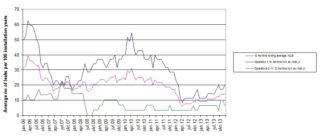PSA 2017 slogan is: Reversing the trend. While this is a good indicator for the way forward, it may be questionable to what extent it can be made sufficiently operationable. And as often it depends on the context.
If you are primarily concerned with occupational health and safety, it may be adequate. Reversing the trend may be implemented in all preventive work, whether it’s to follow procedures for hazardoues work, use of chemicals, noise reduction, use of personal protective equipment or allowing safety reps to use the time needed to perform their functions.
But maybe not so if you are primarily concerned with major hazards. Potential causes of major accidents are associated with performance of day to day operations, inspections and maintenance. We don’t think that cost reductions will start to be reversed. Or that the management will start to tell their employees that the focus shall be on cost increase, rather than cost reduction! What the meaning of reversing the trend is in this context, is far from obvious.
Another complication with major accidents is the long time it may take from when a change is  made (positive or negative) until the effect on major accident risk is noticeable. When the previous major organizational change was made in the Norwegian offshore industry, in 2007 with the merger of Statoil and Hydro, it took 2.5 years before the peak HC leak frequency was reached, as shown in the diagram (Source: Røed & Vinnem. Initial Achievements in Norwegian Oil and Gas Industry Project to Reduce the Number of Hydrocarbon Leaks. ESREL 2013, Amsterdam).
made (positive or negative) until the effect on major accident risk is noticeable. When the previous major organizational change was made in the Norwegian offshore industry, in 2007 with the merger of Statoil and Hydro, it took 2.5 years before the peak HC leak frequency was reached, as shown in the diagram (Source: Røed & Vinnem. Initial Achievements in Norwegian Oil and Gas Industry Project to Reduce the Number of Hydrocarbon Leaks. ESREL 2013, Amsterdam).
PSA is investigating several major accident precursor incidents from the fall of 2016. Statoil has already concluded that they don’t see any connection with cost reduction, but their investigations are usually not very deep when it comes to root causes. PSA investigations are usually better in this regard. It would be a significant contribution from PSA to reversing the trend, if they could finalize investigations within, say a three months period, not the usual 6-12 months as they often have used recently. If these investigation are published in second half of 2017, they surely will not contribute at all to any trend reversing in 2017!
